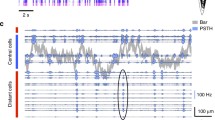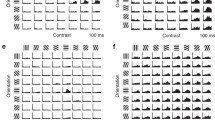Abstract
A method was developed to investigate transfer properties of neurons in the visual system using pictures of complex visual stimuli. The picture is moved over the receptive field of a neuron so that it can scan it along programmed lines. The activity of the neuron during the scanning procedure is presented in a two-dimensional dot display on scale with the original picture. By superposition of the stimulus and the transfer pattern, one can find out to which detail of a stimulus the neuron responds. Neurons in the first intracerebral relay of the visual system, the lateral geniculate body, reduce a complex stimulus, such as a photograph of a natural environment, to its contours. Cortical cells only respond to contours either of a limited or of a wider range of orientations (simple and complex cells, respectively). But the course of contours is only described by a continuous representation of these contours in the cortical map of the visual field. This is done by the simple cells, which have small receptive fields and thus a higher resolving power, whereas complex cells with their large receptive fields monitor the approximate location of a moving stimulus. The function of these two classes of neurons is discussed in terms of visual behavior, i.e., for fixation, hold, and binocular vergence movements (simple cells), and for detection of moving objects and motor command signals towards these objects (complex cells). These functions are an important condition for foveal vision which is the basis of perception in primates. An important function of orientation sensitivity of simple cells may be the binocular alignment of contours in binocular fusion and stereoscopic vision.
Similar content being viewed by others
References
Albus, K.: Exp. Brain Res. 24, 159 (1975)
Albus, K.: ibid. 24, 181 (1975)
Barlow, H.B.: Perception 1, 371 (1975)
Bishop, P.O., in: Handbook of Sensory Physiology, Vol. VII/3A, p. 255 (ed. R. Jung). Berlin: Springer 1973
Bishop, P.O., Henry, G.H.: Invest. Ophthalmol. 11, 346 (1972)
Creutzfeldt, O., in: Progress in Brain Research, Vol. 45, p. 451 (eds. M.A. Corner, D.F. Swaab). Amsterdam: Elsevier 1976
Creutzfeldt, O.D., in: Biophysik — Ein Lehrbuch, p. 629 (ed. W. Hoppe, et al.). Berlin-Heidelberg: Springer 1977
Creutzfeldt, O.: Physiological Conditions of Consciousness. Int. Congr. of Neurology, Amsterdam 1977; Excerpta Med. Congr. Ser. (in press)
Creutzfeldt, O., Innocenti, G.M., Brooks, D.: Exp. Brain Res. 21, 315 (1974)
Creutzfeldt, O.D., Ito, M.: ibid. 21, 324 (1968)
Creutzfeldt, O.D., Kuhnt, U., Benevento, L.A.: ibid. 21, 251 (1974)
Creutzfeldt, O., Rager, G., in: Brain Mechanisms and Conscious Experience (ed. P. Buser). Amsterdam: Elsevier (in press)
Dreher, B.: Invest. Ophthalmol. 11, 355 (1972)
Hammond, P.: J. Physiol. (Lond.) 242, 99 (1974)
Hammond, P., MacKay, D.M.: Exp. Brain Res. 30, 275 (1977)
Heggelund, P., Albus, K.: ibid. 30, 275 (1977) (in press)
Heggelund, P., Hohmann, A.: ibid. 23, 211 (1975)
Hubel, D.H., Wiesel, T.N.: J. Physiol. (Lond.) 160, 106 (1962)
Hubel, D., Wiesel, T.: J. Neurophysiol. 28, 229 (1965)
Hubel, D., Wiesel, T.: J. Comp. Neurol. 158, 267 (1974)
Julesz, B.: Foundation of Cyclopean Perception. Chicago Univ. 1971
Lee, B.B., et al.: Exp. Brain Res. 27, 301 (1977)
Lee, B.B., Cleland, B.G., Creutzfeldt, O.D.: ibid. 30, 527 (1977)
Movshon, J.A.: J. Physiol. (Lond.) 249, 445 (1975)
Noda, H., et al.: Exp. Brain Res. 12, 389 (1971)
Nothdurft, H.C., Creutzfeldt, O.: Science (in press)
Pettigrew, J.D., Nikara, T., Bishop, P.O.: Exp. Brain Res. 6, 373 (1968)
Sanides, D., Donate-Oliver, F., in: Symposium on Architectonics of the Cerebral Cortex (ed. M.A.B. Brazier). New York: Raven Press 1977
Tusa, R.J., Palmer, L.A., Rosenquist, A.C.: J. Comp. Neurol. 177, 213 (1977)
Wässle, H., Creutzfeldt, O.D.: J. Neurophysiol. 36, 13 (1973)
Yarbus, A.: Eye Movements and Vision. New York: Raven Press 1967
Author information
Authors and Affiliations
Additional information
Dedicated to Professor Sir John Eccles on the occasion of his 75th birthday, January 27, 1978
Rights and permissions
About this article
Cite this article
Creutzfeldt, O.D., Nothdurft, H.C. Representation of complex visual stimuli in the brain. Naturwissenschaften 65, 307–318 (1978). https://doi.org/10.1007/BF00368371
Received:
Issue Date:
DOI: https://doi.org/10.1007/BF00368371




